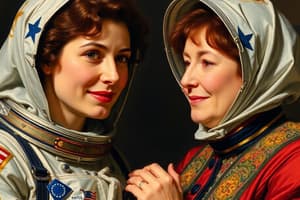Podcast
Questions and Answers
What distinguished Valentina Tereshkova's spaceflight in the context of the Cold War?
What distinguished Valentina Tereshkova's spaceflight in the context of the Cold War?
- It showcased the collaboration between the Soviet Union and other nations in space exploration.
- It was a symbolic victory for the Soviet Union in the Space Race against the US. (correct)
- It demonstrated the Soviet Union's superior technological capabilities in rocket propulsion.
- It marked the end of the Space Race between the US and the Soviet Union.
What specific challenge did Tereshkova face during her training that directly relates to the conditions of space travel?
What specific challenge did Tereshkova face during her training that directly relates to the conditions of space travel?
- Learning complex astro navigation calculations manually.
- Survival training in extreme wilderness environments.
- High-G training maneuvers to simulate launch.
- Extended periods of isolation and zero-gravity simulations. (correct)
Beyond her spaceflight, what leadership role did Tereshkova assume in the Soviet Union?
Beyond her spaceflight, what leadership role did Tereshkova assume in the Soviet Union?
- Commander of the Cosmonaut Corps.
- Minister of Science and Technology.
- Ambassador to the United Nations.
- Director of the Soviet Women's Committee. (correct)
What specific area of medicine did Patricia Bath specialize in?
What specific area of medicine did Patricia Bath specialize in?
What was the significance of Bath's appointment at UCLA's Jules Stein Eye Institute?
What was the significance of Bath's appointment at UCLA's Jules Stein Eye Institute?
What was the primary function of Bath's invention, the Laserphaco Probe?
What was the primary function of Bath's invention, the Laserphaco Probe?
In addition to her medical work, what type of community outreach did Bath engage in?
In addition to her medical work, what type of community outreach did Bath engage in?
What was the connection between Patricia Bath's upbringing and her later professional achievements?
What was the connection between Patricia Bath's upbringing and her later professional achievements?
What was the overall impact of Valentina Tereshkova's spaceflight on the perception of women in the scientific field?
What was the overall impact of Valentina Tereshkova's spaceflight on the perception of women in the scientific field?
How did Patricia Bath's work specifically contribute to global health?
How did Patricia Bath's work specifically contribute to global health?
Flashcards
Valentina Tereshkova
Valentina Tereshkova
First woman and civilian to fly in space in 1963.
Vostok 6
Vostok 6
Space capsule used by Tereshkova for her flight.
Milestone for Women in Space
Milestone for Women in Space
Tereshkova's flight marked a significant achievement in gender equality in aerospace.
Patricia Bath
Patricia Bath
Signup and view all the flashcards
Laserphaco Probe
Laserphaco Probe
Signup and view all the flashcards
Community Ophthalmology
Community Ophthalmology
Signup and view all the flashcards
Hero of the Soviet Union
Hero of the Soviet Union
Signup and view all the flashcards
Supreme Soviet Presidium
Supreme Soviet Presidium
Signup and view all the flashcards
UCLA's Jules Stein Eye Institute
UCLA's Jules Stein Eye Institute
Signup and view all the flashcards
Signup and view all the flashcards
Study Notes
Valentina Tereshkova
- First woman in space
- Soviet cosmonaut and engineer
- First civilian to fly in space
- 1963
- Became a cosmonaut after leaving school at 16
- Worked in a textile factory
- Took up parachute jumping
- Volunteered for Soviet Space Program in 1961
- Trained for 16 months, with zero-gravity conditions
- Launched into space on Vostok 6 in 1963
- Completed 48 orbits of Earth in 71 hours
- Earned a doctorate in engineering in 1977
- Helped as an amateur parachuter during the return journey
Patricia Bath
- Pioneer for women in ophthalmology
- Inventor, laser scientist, and ophthalmologist
- Made huge advances in the prevention of blindness
- American
- Born in Harlem, New York
- Graduated from Howard University in 1968
- Completed residency in ophthalmology at New York University.
- Studied corneal transplantation and keratoprosthesis at Columbia University
- Became associate professor of surgery and ophthalmology at UCLA and Charles R. Drew University in 1974
- Co-founded the American Institute for the Prevention of Blindness in 1976
- Invented the Laserphaco Probe in 1986 to remove cataracts more precisely
- Promoted advanced ophthalmologic techniques in developing nations
- Quote: "To restore sight is the ultimate reward."
Studying That Suits You
Use AI to generate personalized quizzes and flashcards to suit your learning preferences.





